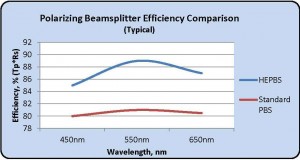High Efficiency Polarizing Beamsplitter- 10% Improvement
By Collin Hayward · Optics PDFs · 27/03/14
The Moxtek® wire-grid polarizer technology offers a reliable, highly durable solution to high quality LCoS display technology with a perfect polarization match to the LC imager. Recent improvements in the polarizing beam splitter (PBS) technology enable a 10% improvement in efficiency.
Table 1 Comparison of Technologies
 Figure 2 shows the center of the circle is a 45ᵒ angle of incidence on the plate. The radius of the circle is 33ᵒ, representing behavior over an f/0.9 cone. The ProFlux beam splitter shows no TIR cutoff, and may be used at a much smaller f/# than the MacNielle PBS, retaining high contrast.
Figure 3, “AOI Comparison for Proflux Wire-Grid and Dichroic Polarizers”, shows how the flat response of ProFlux for rotation in both axes is an indication of its superior performance with skew ray polarization. Dichroic sheet depolarization reduces the ability to maintain high polarization contrast in optical systems.
Figure 2 shows the center of the circle is a 45ᵒ angle of incidence on the plate. The radius of the circle is 33ᵒ, representing behavior over an f/0.9 cone. The ProFlux beam splitter shows no TIR cutoff, and may be used at a much smaller f/# than the MacNielle PBS, retaining high contrast.
Figure 3, “AOI Comparison for Proflux Wire-Grid and Dichroic Polarizers”, shows how the flat response of ProFlux for rotation in both axes is an indication of its superior performance with skew ray polarization. Dichroic sheet depolarization reduces the ability to maintain high polarization contrast in optical systems.

Introduction
This technical brief compares imaging needs and how Moxtek is improving its products. It explains how competing technologies in LCoS projectors compare in terms of brightness, performance, durability and reliability.PBS Efficiency
Efficiency (Tp*Rs) for a polarizing beamsplitter is a measure of how perfectly a polarizer converts randomly polarized light into (reflected) s and (transmitted) p polarized light. If all of the light is converted, then the beamsplitter would be 100% efficient. In reality, some of the light is absorbed, some ‘s’ is transmitted and some ‘p’ is reflected, reducing the efficiency. The Moxtek standard PBS is typically 81% efficient at 550nm wavelength. Recently, with improved manufacturing techniques and new wire-grid technology, this efficiency has been dramatically improved. Figure 1 shows the improvement in efficiency for the Moxtek High Efficiency PBS (HEPBS) versus standard PBS. This represents a 10% improvement.| Element | ProFlux Wire Grid | Dichroic Polarizer | MacNeille Polarizer |
|---|---|---|---|
| Polarizing Mechanism | Polarizer using a nano- structured thin film | Resonant absorption in thick stretched film | Reflects s-polarization and transmits p-polarization |
| Significance | A perfect polarization match to the LC imager, even skew rays can align to the LC. PBS: f/1.5 and below. PPL: f/1.0 and below. | Thick polarizing film results in beam depolarization | Polarization direction depends on incoming ray: skew rays are not aligned to LC |
| Contrast | Excellent brightness, contrast, and on-screen uniformity | Reduced contrast and uniformity | Reduced contrast and uniformity |
| Durability | Made from all inorganic materials for high durability | Polymer film degrades over time and in high flux conditions | Requires polymer waveplate for correct polarization |
Comparison of Other Technologies
Table 1, “Comparison of Technologies”, shows a comparison of wire-grid polarizer, stretched polymer absorbing films (dichroic polarizers), and Brewster’s angle polarizers (MacNeille cubes). Flatter response of ProFlux polarizer across both wavelength and angle creates a more uniform picture from the projector. The wide acceptance angle allows for small f/# optical designs while maintaining color and contrast uniformity. Figure 2 shows an angular map comparison of the Proflux Beam Splitter and the MacNielle Cube.
Figure 2: Angular Map Comparison between a Moxtek Wire-Grid Beamsplitter measured in reflection at 550nm (left), and a MacNeille Cube measured in reflection at 550nm (right).


